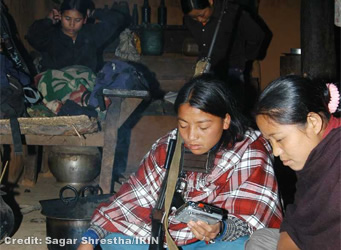 |
 |
| Nepal in Crisis 2006: Facts |
|
|
|
|
|
|
| Ceasefire offers chance to tackle small arms menace |
KAPILBASTU,
2 Jun 2006 (IRIN)
In the remote village of Mahadiyama in Kapilbastu district, 350 km southwest of Nepal's capital Kathmandu, local people still shudder with fear when they recall the murder one year ago of villager Salim Fakir and his elder brothers Jama and Namdan, who were shot dead in cold blood by Maoist insurgents.
A decade of conflict means small arms are everywhere in Nepal
 |
|
The controversial move was slammed by rights groups as a move that would plunge the country into full-scale civil war. In Kapilbastu district alone, 200 people have died since late 2003 at the hands of the army, the Maoists and the vigilantes, local rights groups Insec says.
The spread of these groups as part of the armed conflict has seen an explosion in the number of guns circulating in the country as a whole, say peace activists like Bishnu Upreti. "Over 13,000 people have died during the last decade of conflict and most were killed by army or rebel small arms," he said.
But now in a move that could go some way to halting the proliferation, vigilante groups in Kapilbastu have now started to disband: many are reported to have surrendered their arms to the Maoists. In early May, groups led by notorious vigilante leaders Muna Khan, Murari Kuswaha and Nasir Ali, handed over their arms to local rebel leaders, according to a report by Lumbini Radio, a local FM station in Kapilbastu.
"We are giving up our anti-Maoist campaign as there is now hope for peace due to the ceasefire and talks," said Khan.
 |
|
"There is a need to find a way to control the illegal supplies. Unless that happens the proliferation problem will remain intact," said Upreti.
Activists said the possession of arms, whether legally by security forces or illegally by Maoists rebels and vigilantes, is growing rapidly and desperately requires government intervention.
What's worse is that nobody has any idea of the number of weapons in circulation in Nepal. "There is still no record of the number of small arms used by either the Maoists or the security forces," said Shobha Shrestha from South Asia Small Arms Network (SASANET), a regional group lobbying to reduce weapons proliferation.
Shrestha said her agency would continue to urge Kathmandu to control the illegal importation of arms "so that civilians can live in security". Her organisation is planning to conduct much-needed research into how small arms are currently spreading in Nepal.
"Once we have an accurate picture, it will then be possible to press the government and the rebels to take measures to control the arms supply," said Shrestha.
At the moment, most weapons come into Nepal from neighbouring India. "The rebels mostly receive their arms through illegal suppliers in India, the smuggling of weapons is very easy: it usually takes place along Nepal's porous 1,700 km border with India," Shrestha added.
According to a local NGO, Friends for Peace, the bulk of small arms smuggled into Nepal come from India's illegal arms bazaar just across the border. Activists maintain the only way to control the supply is through concerted cooperation between India and Nepal.
If the ceasefire evolves into a peace process that can draw the rebels into the mainstream political process, disarming them along with the vigilantes might be possible.
But the rebels have already said they are not yet prepared to put down their guns and are waiting for a comprehensive peace process. "It's too early to talk about disarmament. Our war is not over. This is merely a ceasefire," said rebel leader Akash recently.
Even if the ceasefire does lead to peace, on the wider question of controlling the burgeoning number of small arms in the country, activists say the new government needs to commit to a real reduction.
"This is not just a military issue, but the leading cause of human rights abuse, and weapons proliferation fuels the humanitarian crisis in our country," said peace activist Upreti.
| Credit
IRIN 2006 Copyright © UN Office for the Coordination of Humanitarian Affairs 2006 [ This report does not necessarily reflect the views of the United Nations] Integrated Regional Information Networks (IRIN), part of the UN Office for the Coordination of Humanitarian Affairs (OCHA). |
| Links |
| External Links |
| UNFPA | OCHA |
|
|
|
|

